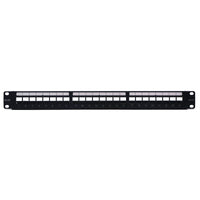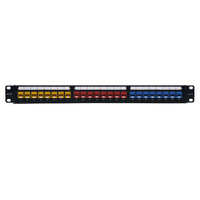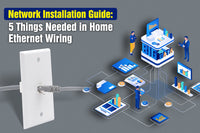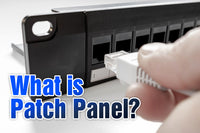Are you considering building a solid IT environment, an efficient office network, or a data center? If so, you’ll discover that a rack installation will most likely be the heart of the setup. Neglecting to arrange your servers, switches, patch panels, and other equipment can result in breaking the stability of your network.
In this guide, we’ll see the tools you’ll need, the best and proven practices for server rack setup and network rack setup, and the detailed steps you’ll need to follow to achieve an efficient and future-proof infrastructure.
The Importance of a Proper Rack Installation
A standard rack server is usually used to house and organize different network devices, like switches, servers, and other hardware. A well-executed rack installation guarantees easy access for upgrades, maintenance, and repairs. The main advantages of a proper rack installation include:
- Cooling and Ventilation: Overheated equipment will fail sooner or later. Yet, with a properly installed rack system, all the devices get sufficient airflow and prevent that eventual total failure. Proper ventilation also extends the lifecycle of the equipment and improves the overall network functioning.
- Cable Management: Tangled cables can also cause accidental disconnections, not to mention how any troubleshooting task seems to take ages of time. An organized network rack setup facilitates quick identification of the cables - important for expansions and faster repairs. At the same time, you’ll avoid the unprofessional appearance of messy wires.
- Scalability: When planning the setup, consider leaving some extra rack space free so any future hardware addition won’t require substantial overhauls. This is particularly helpful for growing companies or expanding networks.
- Professionalism and Safety: A clean rack speaks of professionalism. But what matters most is safety. From a safety standpoint, balanced loads and secured hardware diminish the risk of accidental tip-overs or damaged connectors.
Rack Types
When planning your rack installation, one of the first things to do is to select the right rack type and check that its size suits your equipment and future additions. We’ll begin by overviewing the most common types of racks and size considerations.
Two-Post vs. Four-Post Racks
To mount two-post racks, the equipment has to be bolted to two vertical posts, in most cases at the front. They are simple, cheaper than other types, and occupy less space. They are a good choice for small IT rooms or closets with minimal depth requirements and lightweight devices. For heavier equipment, as in deeper servers, you’ll need to add extra bracing.
Four-Post Racks come with front and rear mounting rails and can give proper support for deeper and heavier serves. They are stable, and the rail depth can be adjusted. More expensive and bigger than two-post racks, these racks are a smart choice for data centers or server rooms that need versatile mounting and strong support.
Open-Frame Racks vs. Enclosed Cabinets
Open-Frame Racks provide maximum airflow and make accessing the devices a very easy task as their sides are exposed (and sometimes the top or bottom too). Usually quite affordable, open-frame racks are preferred for their cooling potential and for easing cable management. However, as they don’t have any built-in security or dust protection, they are a good choice for areas with restricted access and without dust, such as server closets or test labs.
Unlike open-frame, enclosed cabinets are surrounded by doors or panels, often with locks. They come with airflow pathways, with built-in fans or perforations at the doors, but may need additional cooling accessories to keep a decent airflow. They provide more security and dust protection. They are used mostly in data centers, server rooms with controlled access, or in public areas.
If you are looking for a smaller server rack for limited office or home space, a wall-mounted rack is an affordable solution to keep your network equipment organized and efficient.
Rack Size
Here are some things you need to know about rack size:
- Rack size is typically measured in “Rack Units” (U-Size);
- Each “U” measures 1.75 inches of vertical space.
- The most common heights range from 8U up to 48U or more.
- Smaller setups do well with only 8U–25U.
Depth & Load Capacity
Depth: Make sure to verify both equipment depth and cable clearance. Standard racks vary from around 24 to 48 inches in depth.
Weight: Check the manufacturer’s stated load limit. Some equipment, like large UPS (Uninterruptible Power Supply) systems and full-sized servers, can quickly reach or exceed typical 2-post weight capacities.
Essential Tools for Rack Installation
Before jumping into a network rack installation or server rack installation, get all the tools and materials. If you have all the items you’ll need handy, it will help to accelerate the process and ensure you won’t need to pause your work to seek any tool or gadget:
- Measuring Tape – For precisely assessing the space required in your server room or office.
- Screwdrivers & Drill – You’ll use them to secure mounting rails, brackets, and hardware.
- Rack Screws & Cage Nuts – Fasteners designed specially to hold heavy-duty equipment in place.
- Level – Ensures your rack is straight, supporting even weight distribution.
- Cable Management Accessories – Velcro straps, cable ties, and cable organizers keep cords tidy.
- Power Tools (Optional) – May speed up the installation, but be careful if you use them to prevent over-tightening.
- Protective Gear – They are the typical gloves and safety glasses for personal protection.
Planning Your Network Rack Installation and Server Rack Setup
Measure The Space and Requirements
Every rack installation begins with a thorough evaluation of the site or area.
- Measure the sizes of the equipment you’ll store in the rack and then calculate what size the rack has to be to accommodate your equipment comfortably, and even better, provide some additional free space for future additions to the network.
- Make sure you have sufficient space for the new rack or racks, as well as room for airflow on the back, front, and sides of the rack. Likewise, verify if the floor can withstand the weight of your rack once fully loaded.
- Measure the space around your rack to allow proper airflow. Place racks far from heat sources or areas where there’s humidity.
Choose the Right Rack
Racks usually come in different sizes and types, like open-frame racks, enclosed cabinets, 8U or 48U racks, and each of them is tailored to particular needs. For example, enclosed racks or cabinets are more suitable for data centers or server rooms as they provide added security and airflow control. While wall-mounted racks are perfect for network rack setups in small offices where floor space is limited.
Server Rack Installation
Position the Rack
- The first thing you need to do is to find the best location. Use the measuring tape and a floor plan, and mark the exact position where you’ll place the rack.
- Use a level to confirm your rack stands upright and regulate leveling the feet, or add shims to stabilize the base. If you’re installing a wall-mounted server rack, make sure that the rack won’t fall off.
Install the Mounting Rails and Shelves
- Mounting Rails: Most server rack setups have adaptable rails to house diverse equipment depths. Secure them with screws and cage nuts.
- Rack Shelves: Some hardware, for example routers or other small accessories, might not fit into the standard rack rails. You might have to install a shelf to hold them securely.
Placement and Security of the Equipment
- Position Heavy Items First: Place servers, switches, or UPS units near the bottom to lower the rack’s center of gravity.
- Align Front and Rear: Confirm that both front and rear mounting brackets are correctly aligned to properly withstand the weight and diminish device vibration.
- Use the Correct Fasteners: Always use the rack screws or cage nuts recommended by the manufacturer to avoid damaging threaded holes.
Cable Management and Power Distribution
- Plan Your Cable Routes: Label or color-code cables for quick identification. Route them far from heat sources and avoid sharp edges.
- Use Velcro Straps: Unlike plastic zip ties, Velcro straps can be effortlessly repositioned as your server rack setup evolves.
- Power Distribution Units (PDUs): Position PDUs in a way that allows proper cable runs and causes minimal tension on cords. PDUs also aid in controlling electrical usage, preventing overloads.
Final Checks
- Verify Connectivity: Power up each device and confirm network connectivity.
- Control Temperatures: Use built-in sensors or external devices to monitor that no equipment gets overheated under load.
- Tidy Up: Neatly bundle excess cables, remove loose packaging materials, and grant clear and safe walkways around the rack.
Installation and Maintenance Tips
Even a perfectly planned rack setup needs continuing attention. Let’s see some tips you should follow from the moment you begin your rack installation and after it’s fully functional. These recommendations will help protect your equipment, maximize airflow, and make future upgrades easier.
Weight Distribution
- Put Heavier Equipment at the Bottom: Place items like UPS or large servers in the lowest part of the rack. This helps to stabilize the center of gravity of the rack and cuts tipping risks.
- Use Rails Correctly: Verify that all sliding rails or mounting brackets are securely installed following the manufacturer’s instructions. Loose rails can result in sagging or misalignment.
Plan Cable Routes Smartly
- Separate Power and Data Cables: If feasible, run power and data cables on different paths, as separately as possible, to lessen electromagnetic interference (EMI).
- Cable Bundling: Group cables by their function and secure them with Velcro ties instead of plastic zip ties. With Velcro, it will be easier to make any adjustments. Besides, Velcro doesn’t damage the cable jacket.
Give Space for Future Growth
Leave Rack U-Space: Keep at least 10–20% of your rack space unoccupied to accommodate more hardware in the future.
Monitor Both Temperature and Humidity
- Use Environmental Sensors: Many modern racks or PDUs have built-in sensors that control temperature and moisture. Maintain your environment in the ideal range—often around 68–72°F (20–22°C) and 45–55% humidity.
- Hot Spots: If you detect high temperatures in certain rack sections, consider adding localized cooling or repositioning cables to improve airflow.
Cable Management
Use organizers to avoid tangled wires and prevent potential strain. Label all cables accurately. A single unlabeled cable can complicate maintenance or lead to accidental disconnections.
Plan for Downtime Properly
- Maintenance Windows: If you need to replace a PDU or reposition major components, schedule that work for a low-traffic time.
- Redundancy Checks: After any important changes, test failover. For instance, you could fake a power supply failure to confirm your redundant setup works as it should.
Final Thoughts on Rack Installation
A correctly designed rack installation will be the foundation of your infrastructure, ensuring stable functioning and minimal downtime. If you follow an organized approach, you set the stage for a network that is adaptable to new, increased demands.
For more information on this topic, you can keep up on our blogs. While VCELINK offers general and basic information for our customers and other visitors to the website, it’s not professional advice.





Be the first one to comment.
Leave a comment